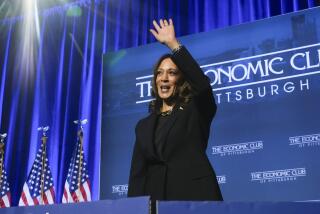Clinton Blames Bush for Loss of Blue-Collar Jobs : Campaign: Democrat says U.S. response has been poor. He describes his own plan to help retrain workers.
- Share via
PORTLAND, Conn. — Democratic presidential nominee Bill Clinton on Tuesday pressed his charge that President Bush has mishandled the economy, using a manufacturing plant as his stage to lament the loss of blue-collar jobs and to flesh out a plan to resurrect the nation’s manufacturing base.
At the Standard-Knapp corporation here--and later at a rally outside an East Haven, Conn., restaurant--Clinton sought to place the blame squarely on the incumbent for the ebbing away of America’s once-stalwart manufacturing base.
“The percentage of our workers employed in the manufacturing sector has continued to decline,” despite productivity gains posted by many companies, Clinton told the Standard-Knapp workers, who assemble packaging machines.
He said, “Just in the last four years, we’ve lost 1.3 million manufacturing jobs.”
The federal Bureau of Labor Statistics confirmed Tuesday that the number of U.S. manufacturing jobs has fallen by 1,388,000 since Bush took office in January, 1989, to 18,150,000. Total non-farm employment grew slightly over the same period, increasing 188,000 to a total of 108,517,000 as of last month, with most of the growth in government employment.
Clinton decried the lack of a coordinated national response to the manufacturing sector’s job decline.
“Unlike our competitors, this country has no national strategy, no comprehensive partnership between business and workers and education and government to create the kinds of high-wage, high-growth jobs in manufacturing that I think are critical to our future,” he said.
Clinton’s Tuesday campaign message was meant to build upon his Labor Day efforts to depict Bush as a man who has allied himself with the rich and powerful and has forgotten needy and working Americans.
As part of offering himself as an alternative, Clinton announced what he touted as a new manufacturing policy, which largely tied together proposals he has advanced throughout his presidential campaign.
One new element in the plan calls for establishment of 170 high-tech centers that would serve as incubators for new manufacturing ideas, which would then be shared with small- and medium-sized companies. The centers would be modeled after the agricultural extensions common in rural areas of the country.
Clinton said the centers would solve the “technological gaps” that plague smaller companies, as well as retrain the scientists and engineers previously employed in the dwindling defense industry.
“There are 200,000 unemployed defense workers, technicians, scientists and engineers in California alone today,” Clinton said. “And these people have all this incredible potential to add to our national wealth, but we don’t have a system for moving them from the defense sector into the non-defense sector. The extension centers will help to do this.”
Later, however, Clinton said only 25 of the centers would be “almost exclusively” dedicated to defense workers, and another 25 to the manufacturing industry. Also, it was unclear where they would be located.
In describing his plan, Clinton demonstrated the difficulty of trying to mount a campaign as a “new style” Democrat, who is focused on the technologies and jobs of the future, and still satisfy the desires of organized labor, which has come aboard his campaign vigorously and has provided a sizable portion of the crowds at many of his recent rallies.
For instance, Clinton suggested repeatedly Tuesday that the U.S. should mimic the approaches of its chief economic competitors.
“Everybody knows we’ve lost a lot of auto jobs in the last 10 years and we’ve lost a lot of steel jobs in the last 10 years,” Clinton said. “But if you look at the Germans and the Japanese . . . when they moved people out of automobiles, they moved into other manufacturing technologies with a future. When our people moved out of automobiles, they moved into the unemployment lines.”
At the same time, though, Clinton sought to show that he remains concerned about the plight of the more traditional businesses that organized labor is trying to salvage.
To that end, he scored Bush for staging a Labor Day campaign event that he suggested missed the point.
“Just yesterday, President Bush had a great photo (opportunity) walking across the bridge that connects Mackinac Island to the mainland of Michigan--a bridge that was built with steel from a mill that is closed in the last four years,” he said.
Ultimately, Clinton settled on mixing a stew of Republican and Democratic ideas for reviving the economy.
“We’ve got to get rid of regulations that don’t make sense,” said Clinton, echoing a line that has been standard in GOP rhetoric. Then he added a distinctly liberal element: “And we’ve got to permit our companies to join together . . . as long as it doesn’t affect their competitive pricing here at home.”
At the rally in East Haven, Clinton reiterated his belief that a combination of approaches is needed to solve the nation’s economic woes.
“A lot of the problems we face today don’t fall very neatly in categories of left and right and liberal and conservative and Republican and Democratic,” he said. “We are living in a post-Cold War world where we are fighting and competing for every dollar we get.”
In general, Clinton has pledged to use the U.S. tax code to benefit domestic businesses and has promised to transfer money saved in defense cutbacks to job-creating programs.
He argued Tuesday, as he has throughout the campaign, that existing tax codes propel many companies to set up operations outside the United States, stripping the nation of jobs as a consequence.
He won his only applause from the Standard-Knapp workers when he pledged to “copy our competitors” and put the heft of the government behind businesses.
“The tax system in America should work to benefit Americans without being protectionist,” Clinton said.
The Arkansas governor also promised to streamline export laws to help companies compete overseas and said he would bolster the export offices in U.S. embassies worldwide.
Overall, Clinton said, his plan would cost about $2 billion a year over five years, financed with money now spent on military research.
Today on the Trail . . .
Bill Clinton campaigns in Atlanta and Jacksonville, Fla.
President Bush campaigns in Norristown and Collegeville, Pa., and Middletown, N.J.
Vice President Dan Quayle attends a rally in San Diego and addresses a San Diego Rotary Club luncheon.
*
TELEVISION
Clinton is interviewed on WJXT’s “Florida talks to Clinton.” C-SPAN will air it live at 5 p.m. PDT.
Tennessee Sen. Al Gore is interviewed on CNN’s “Larry King Live” at 6 p.m. PDT.
More to Read
Get the L.A. Times Politics newsletter
Deeply reported insights into legislation, politics and policy from Sacramento, Washington and beyond. In your inbox twice per week.
You may occasionally receive promotional content from the Los Angeles Times.











